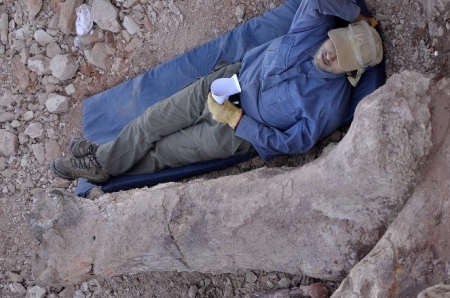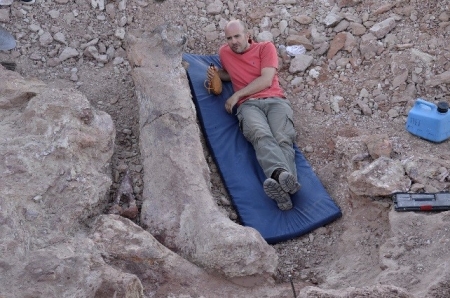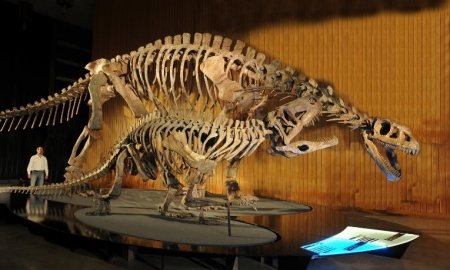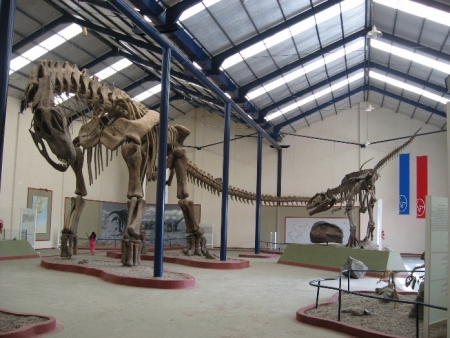How did the sauropod dinosaurs grow so big?


Ignacio Cerda (about 1.9m tall) taking a break during the excavation alongside a femur of what is now considered to be the largest known dinosaur.
Standing about 15-20m tall with body lengths in excess of 30m, and weighing roughly about 8-10 African bull elephants, the long necked dinosaurs (the sauropods), were the largest animals to live on our planet. How did these animals attain their gigantic stature? How long did they grow? Answers to these questions are presented in a recent Argentinian-South African collaborative study involving Professor Anusuya Chinsamy-Turan, from the Department of Biological Sciences at UCT.
The sauropods, and their ancestors the “prosauropods”, belong to a group of dinosaurs called the Sauropodomorpha. Interestingly, about 190 million years ago South Africa and Argentina were common stomping grounds for these early dinosaurs, and the remains of such animals are often found as fossils in these countries. Over the past decade or so, several more sauropodomorph dinosaurs have been discovered, that have helped shed light onto how the transition from basal to more derived forms occurred. Several of these newly described dinosaurs, appear to have a mosaic of derived and basal features that makes them clearly “transitional” dinosaurs. A good example of such an intermediate dinosaur is the South African dinosaur, Antetonitrus which was described in 2009.

Alejandro Otero sizing himself up next to a femur of a large titanosaur discovered 2 years ago
For almost two decades scientists thought that the “prosauropods” took several years to reach adult body sizes as indicated by growth rings in their bones, while the more derived sauropods appear to have had faster growth rates that allowed them to grow up rapidly without periods of periodic slowing down, and only during late stages of their lives did they develop growth rings in their bones.

Lessemsaurus, described in this study is a large sauropod; seen here with Oscar Alcober, Director of Museo De Ciencias Naturales de la Universidad Nacional de San Juan
After studying the microscopic structure of the bones of 13 different sauropod dinosaurs from South Africa and Argentina, as well as that of 12 others described previously, these researchers reached an extraordinary conclusion: although some sauropods grow up rapidly without pauses in their growth, there were others (like Lessemosaurus (see picture), about 10m in length) that were also giants, but they took the energetically less expensive route of growing cyclically i.e. with alternating slow and fast rates of growth, thus, taking several years to reach their grand size. On the other hand, these scientists found that some of the basal forms, like Mussaurus (about 5-6m in length), contrary to the previous hypothesis, grew rapidly like the more derived sauropods, and did not have alternating periods of slowed and fast growth expected for like basal forms. Thus, this study has shown that the long held view that the basal and derived Sauropodomorpha had different growth patterns is no longer valid. As Argentinian palaeontologist Dr. Ignacio Cerda says, “More research can often lead to a reassessment of previous hypotheses….this is the nature of Science”. It now appears that among the Sauropodomorpha, some of them (especially the most derived ones) grew rapidly to adulthood, whilst others (irrespective of whether they were basal or derived sauropods) took the energetically less expensive, but slower, more protracted route to reach gigantic proportions. Prof. Chinsamy-Turan said “Our study of more recently discovered dinosaurs permitted fresh perspectives into the lives of these giant dinosaurs”.

Argentinosaurus, one of the largest sauropod dinosaurs known.
Argentinian palaeontologist, Diego Pol one of the key people involved in the discovery two years ago of the largest ever titanosaur says, “Finding new dinosaurs is thrilling, but it is just the first step in understanding the biology of these colossal animals.”
